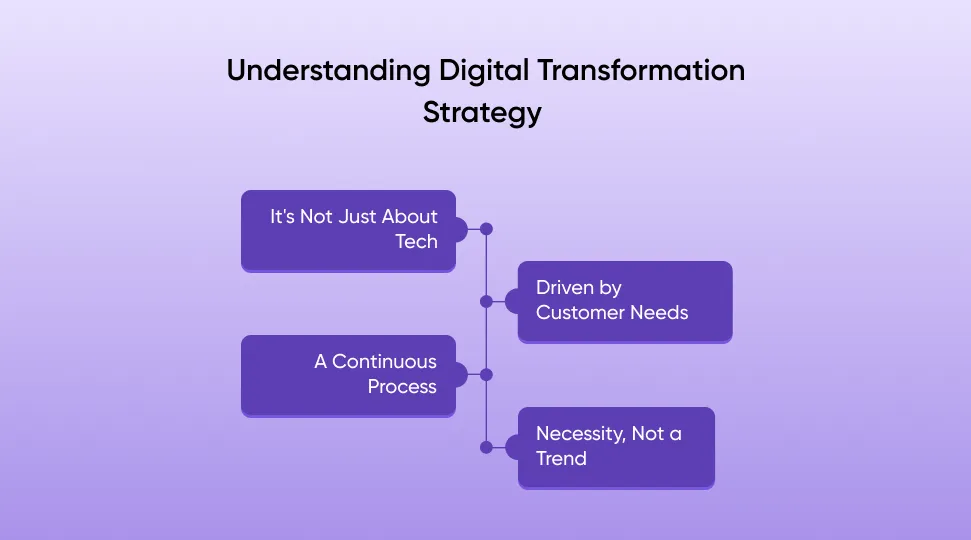Business

5 min

Discover top digital transformation strategies essential for staying competitive in today's market. Learn why digital transformation is crucial, key components of a successful strategy, benefits, challenges, and real-world case studies.

By Dhruv Joshi
28 Mar, 2024
The question is not if you'll apply digital transformation but when. The time for outdated business models is over. This blog will explain why a digital transformation strategy is essential to staying competitive. Discover actionable ways to integrate cutting-edge technologies that streamline operations, drive innovation, and create a more agile company.
Top Trending Digital Transformation Strategies Stats You Should Know
Strategic Investment: 70% of companies already have a digital transformation strategy.
Competitive Advantage: Companies with a solid digital focus are 26% more profitable than their industry peers. (Source: MIT Sloan)
Customer-Driven Change: 89% of businesses believe digital transformation to be a key driver in improving customer experience. (Source: AIMultiple)
 Digital transformation has become a business buzzword, but what does it mean? It goes far beyond simply adopting new technologies. Digital transformation is a core shift in how a business operates, interacts with customers, and makes decisions. Here's what you need to know:
Digital transformation has become a business buzzword, but what does it mean? It goes far beyond simply adopting new technologies. Digital transformation is a core shift in how a business operates, interacts with customers, and makes decisions. Here's what you need to know:
It's Not Just About Tech: While technology is a crucial enabler, digital transformation involves company culture, processes, and customer relationships.
Driven by Customer Needs: Successful transformations use technology to create better customer experiences and value.
A Continuous Process: Digital transformation isn't a project with an end date; it's an ongoing evolution as technology and the market change.
Necessity, Not a Trend: In the digital age, transformation is critical to staying competitive and relevant.
Well-crafted digital transformation strategies align your technology investments and internal changes and focus on the customer. A comprehensive strategy:
Provides Direction: Outlines clear goals, priorities, and the path forward.
Enables Smarter Decisions: Ensures technology adoption serves the overall business vision.
Fosters Alignment: Guides all departments and levels of the organization towards the same transformation goals.
Increases Adaptability: Allows for flexibility and adjustment as the digital landscape shifts.
Digital transformation can be complex, but with a clear understanding and a strategic approach, your business can seize the opportunities offered by the digital era.
Well-structured digital transformation strategies are the foundation for success. Here's a breakdown of the essential elements to consider when crafting yours:
Customer-Centricity: Understanding your customers' needs, behaviors, and pain points is vital. Aim to use digital tools to create personalized experiences, convenient touchpoints, and build stronger relationships.
Operational Efficiency: Identify processes that can be streamlined, automated, or re-imagined entirely through technology. This frees up resources and improves productivity.
Data-Driven Decision-Making: Develop a robust data analytics strategy. Use insights from customer behavior, internal operations, and market trends to guide investments and actions.
Technology Roadmap: Assess your current tech landscape and determine which technologies align with your goals. As you plan, consider cloud adoption, AI/Machine Learning, IoT, automation, and robust cybersecurity.
Culture of Innovation: Digital transformation isn't just about the tools—it's about evolving your company's mindset. Foster a culture that encourages experimentation, values data-driven insights tolerates calculated risk-taking and celebrates learning from successes and failures.
Agile Methodology: An agile approach suits digital transformation well. Use small-scale projects, quick iterations, and continuous learning to adapt your strategy as you see results.
Leadership Buy-in: Strong leadership support and commitment are crucial for digital transformation. Champions at the top level ensure resources are allocated, and that cross-functional teams collaborate to make change happen.
The importance of web and progressive web app development in providing seamless experiences across different devices and platforms cannot be overstated. These technologies enable businesses to reach their customers effectively, ensuring consistent interactions regardless of the device or platform used. They facilitate accessibility, enhance user experience, and contribute significantly to the success of digital transformation initiatives.
 Companies that successfully grab digital transformation reap many benefits that propel their business forward. Here are some of the key advantages:
Companies that successfully grab digital transformation reap many benefits that propel their business forward. Here are some of the key advantages:
Improved Customer Experience: Digital technology lets you offer more personalized, seamless, and omnichannel experiences, driving customer satisfaction and loyalty. Developing mobile apps using Android, iOS, Flutter, or React Native can enhance customer experiences and improve operational efficiency.
Enhanced Operational Efficiency: Automation, streamlined processes, and real-time data insights lead to improved efficiency, lower costs, and better resource allocation.
Data-Driven Decision Making: Collect and analyze data for informed choices, better forecasting, and identifying business opportunities.
Increased Innovation: Digitally-supported rapid prototyping and experimentation foster a culture of innovation, helping you uncover new revenue streams and business models.
Boosted Agility: Quickly adapt to changing customer expectations, market shifts, or disruptions.
Competitive Advantage: Outpace competitors by providing better experiences, improved operations, and bringing new products and services to market faster.
Well-executed digital transformation strategies aren't just about technology – it's about unlocking the potential for growth in a rapidly changing world. These advantages offer businesses:
Increased profitability through greater efficiency and better products/services.
Stronger brand reputation fueled by enhanced customer experiences.
Employee empowerment through advanced tools and continuous learning.
While digital transformation can bring tremendous benefits, using a strategic mindset is vital. By defining goals, fostering a collaborative culture, and choosing the right technology, companies can position themselves for sustainable success in the digital age.
Before crafting your digital transformation strategies, a critical first step is understanding your business's current level of digital readiness. This assessment will provide invaluable insights into your strengths, weaknesses and where to start your transformation efforts.
Here's a step-by-step process to assess your digital readiness:
Evaluate the age and efficiency of your hardware, software systems, networks, and cloud capabilities.
Identify areas where outdated technology might hinder new initiatives.
Examine your employees' level of digital literacy, comfort with existing technologies, and openness to adopting new ones.
Assess your organizational culture toward innovation and risk-taking, which are essential for transformation.
Evaluate how you collect, store, manage, and analyze data.
Identify gaps in data analytics and insights that can support a digital transformation strategy.
Analyze digital touchpoints such as your website, mobile experiences, and digital communication channels.
Consider how well these align with modern customer expectations and how they can be improved.
Conduct a comprehensive analysis of your competitors' digital presence, technology adoption, and online customer experiences.
It will help you identify areas where you may be lagging.
Highlights Strengths and Weaknesses: Provides a clear picture of areas where you are ready for transformation and where investment needs to be prioritized.
Identifies Opportunities: Uncovers potential areas where digital solutions could drive efficiency and boost innovation.
Informs Strategy: Allows you to craft a digital transformation strategy tailored to your company's specific needs and readiness, increasing your chances of success.
Well-crafted digital transformation strategies are the cornerstone of any successful transformation effort. Let's outline some essential strategies to consider:
Place your customer at the very heart of your transformation. Use technology to understand their needs, personalize interactions, and provide seamless experiences across all touchpoints. Thus, UI UX design, wireframing, and prototyping are significant in understanding user needs and enhancing engagement.
Digital transformation thrives with experimentation and calculated risk-taking. Foster a culture where employees feel authorized to suggest new thoughts, challenge the status quo, and learn from successes and failures.
Identify manual, repetitive tasks ripe for automation. Implement tools for robotic process automation (RPA) or rationalize workflows to save time and reduce errors. This frees up your staff to focus on higher-value activities.
A data-driven approach is critical. Invest in data analytics tools to gather insights from customer interactions, operational processes, and market trends. Use these insights to optimize decision-making and identify new opportunities for efficiency or growth.
Explore the ever-evolving technology landscape to find solutions that align with your goals. Consider cloud computing, artificial intelligence (AI), the Internet of Things (IoT), and tools that enhance collaboration and communication throughout your organization.
Businesses with successful digital transformation see an average of 23% higher revenue growth. Explore our resources to unlock similar results for your business.
Successful digital transformation rewrites the rules for how businesses operate. While the rewards can be immense, the path is not without obstacles. Here are some common challenges and ways to proactively address them:
Transformation efforts become scattered and ineffective without a defined vision. Solution: Align your digital transformation strategies directly with your overarching business objectives.
Change, even positive change, can be met with resistance. Solution: Proactive change management with transparent communication, training, and celebration of success stories will help mitigate pushback.
Digital transformation can be an investment. Solution: Start with more minor, impactful projects. Success here can provide the proof points needed to justify further investment.
Do you have in-house expertise? Solution: Conduct a skills gap analysis. Training, upskilling, or targeted hiring of specialists may be necessary. Consider partnerships for areas where building internal skills is impractical.
Increased reliance on data makes cybersecurity paramount. Solution: Build robust security measures into your digital transformation strategy from the start, not as an afterthought.
Outdated systems can hinder transformation. Solution: Plan for a phased approach, eventually moving to cloud-based services for greater flexibility and scalability.
Do you know? Leveraging cloud services like AWS, Google Cloud, or Azure can address scalability concerns, and enable cost-effective solutions. It can reduce risks.
Now, let's move forward to the successful case studies of top firms.
 Learning from real-world companies and their stories is one of the best ways to find inspiration for your digital transformation strategies. Here are a few notable case studies that illustrate the power of a clear digital transformation plan:
Learning from real-world companies and their stories is one of the best ways to find inspiration for your digital transformation strategies. Here are a few notable case studies that illustrate the power of a clear digital transformation plan:
Domino's turned their business around with a massive digital focus. They built user-friendly online and mobile ordering, real-time pizza tracking, and even integrated ordering via smart home systems. This customer-centric approach revitalized their business.
Facing decline, LEGO applied digital transformation. They created online communities for fans, used data insights to inform product development, and even developed movie franchises and video games. It reinvigorated their brand and expanded their market reach.
Nike's digital strategy focuses on direct-to-consumer relationships with personalized experiences. Their apps and membership programs create a sense of community and exclusivity, encouraging customer loyalty and driving sales.
Digital transformation is not a one-and-done project. It's a continuous journey of adaptation and innovation. By using digital solid transformation strategies, investing in your people, and selecting the right technologies, you'll put your business on the path to thriving in the digital age.
It's time to start your digital transformation. The future belongs to businesses that grab change and leverage technology to its fullest.
Develop your digital transformation strategies by contacting us, empowering your team, and beginning to take practical steps toward a more competitive, resilient, and customer-centric future.
Ans: Digital transformation strategy refers to a complete plan adopted by businesses to leverage digital technologies to fundamentally change how they operate, interact with customers, and make decisions. It goes beyond adopting new technologies and involves reshaping company culture, processes, and customer relationships to stay modest and relevant in the digital age.
Ans: Digital transformation strategies are crucial for businesses to stay viable and relevant in today's rapidly evolving world. It provides direction by outlining clear goals and priorities, enables more thoughtful decision-making by aligning technology adoption with the overall business vision, fosters alignment across departments and levels of the organization, and increases adaptability by allowing for flexibility and adjustment as the digital landscape shifts.
Ans: Digital transformation strategy key principles include:
Ans: A digital transformation strategy brings several benefits to businesses, including Improved Customer Experience, Enhanced Operational Efficiency, Data-Driven Decision Making, Increased Innovation, Boosted Agility, and Competitive Advantage.
Ans: Businesses can assess their readiness for digital transformation by Analyzing Current Technology Infrastructure, Assessing Digital Skills and Culture, Analyzing Data Proficiency, Evaluating Customer Experience, and Benchmarking Against Competitors. Asking critical questions related to adaptability, leadership support, customer feedback, and investment in talent development.
Top 11 Must-Have Features of a Custom Web Application in 2026
By Dhruv Joshi
5 min read
Generative AI Tech Stacks: Choosing the Right Tools for Scalable AI Development
By Dhruv Joshi
5 min read
Choosing Best Tech Stack for Web App Development: Performance, Cost, and Scalability
By Dhruv Joshi
5 min read
Top 9 Tech Stacks for Scalable Web Application Development
By Dhruv Joshi
5 min read

Business

5 min
Plan hr software development the practical way: must-have HRMS features, event-driven architecture, integrations, security controls, and a clear build roadmap. Use cost ranges, effort tables, and partner checklists to choose reliable hr software development companies. See persona-based workflows, a build-vs-buy matrix, and budget levers to launch an HRMS that reduces errors, speeds onboarding, and delivers audit-ready analytics.


Business

5 min
Learn how pharmacy management software development streamlines dispensing, inventory, billing, and patient engagement. This comprehensive guide covers software types, core modules, tech stack, step-by-step process, must-have 2026 features, costs, and tips for hospitals and independent pharmacies. Build secure, interoperable, cloud-ready pharmacy management software that reduces errors and improves care outcomes.


Business

5 min
Telemedicine app development is transforming healthcare by enabling secure, remote care through video, chat, and monitoring tools. Telemedicine apps support urgent care, chronic management, and mental health, while key features include e-prescriptions, EHR integration, and secure payments. Choosing the right telemedicine app development services partner requires proven healthcare expertise, HIPAA/GDPR compliance, scalable cloud architecture, transparent pricing, and strong post-launch support.


Feeling lost!! Book a slot and get answers to all your industry-relevant doubts